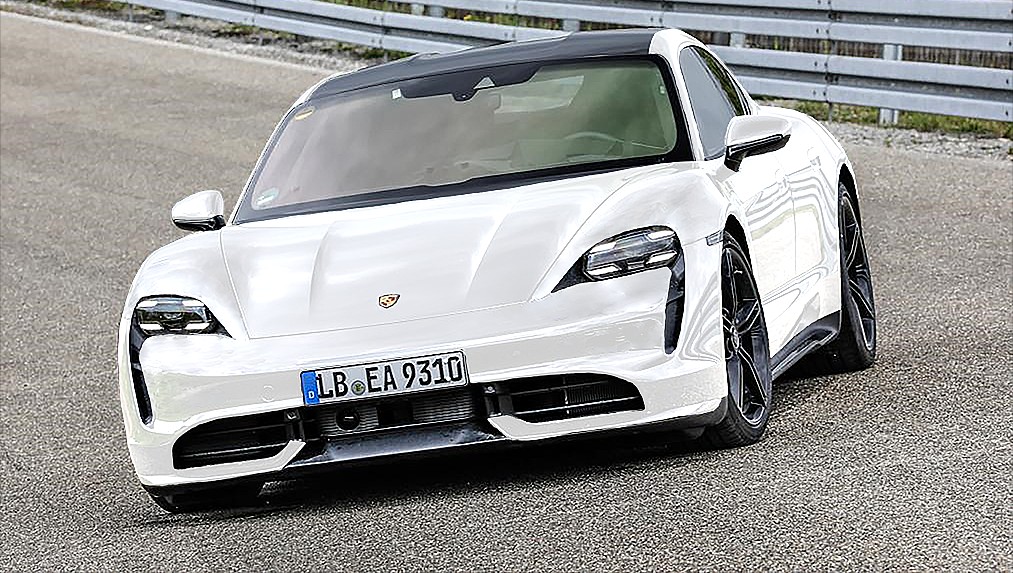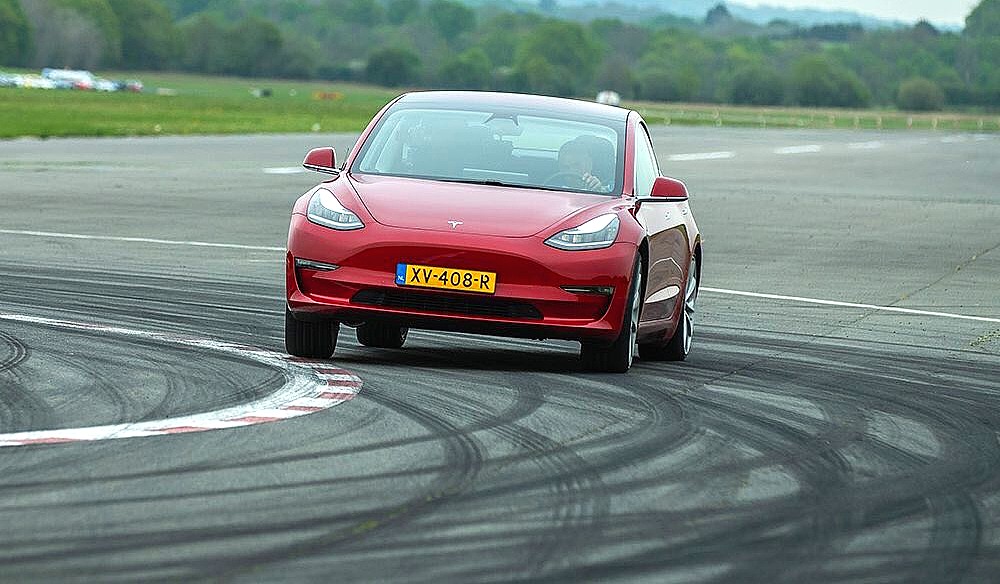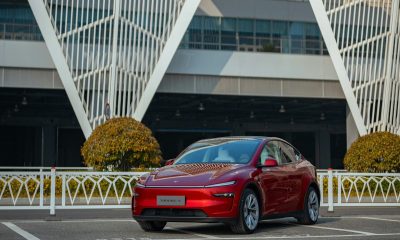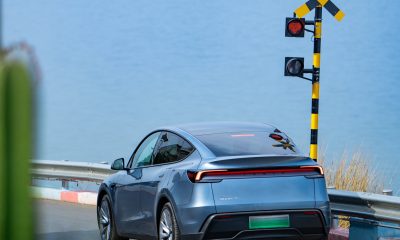

News
Porsche Taycan Turbo specs: 96 kWh battery, 600+ hp, air suspension, and repeatable peak performance
The Porsche Taycan is arguably one of the most highly-anticipated electric cars this year, and for good reason. The Taycan is Porsche’s first modern all-electric car, bred with racing DNA and technology honed in the track from hybrids like the 918 Spyder and the 919 Hybrid Evo. It is then incredibly pertinent for Porsche to ensure that the Taycan, particularly its top-tier “Turbo” variant, will not disappoint in any way.
A recent review of a Taycan Turbo pre-production prototype suggests that the top-tier variant of Porsche’s electric car could live up to its name, and then some. During a ride-along, Car Magazine European editor Georg Kacher was able to get up close with the upcoming vehicle as it tore through the streets with Porsche’s chief engineer Stefan Weckbach.
Equipped with a 96 kWh lithium-ion battery that weighs 650 kg (1,433 lbs), a 215 bhp/221 lb-ft powerplant on the front axle, and a 402 bhp/406 lb-ft motor at the rear, the Taycan boasts 649 lb-ft of peak torque. That’s enough to propel the car from a dead stop to 60 mph in just over 3 seconds and into 124 mph in less than 10 seconds. It’s not just acceleration, too, as the vehicle is capable of cruising at 162 mph for miles without its battery overheating. Couple that with standard air suspension and a regenerative braking system that is controlled through the steering wheel, and the Taycan becomes an EV that is made from the ground up like every other Porsche: a car that is simply fun to drive.

Porsche notes that the Taycan can perform ten full-throttle 0-62 mph and four 0-124 mph launches without seeing a decrease in performance. The vehicle does enter a “limp mode,” but only when the distance to empty reads zero. With a 96 kWh battery and a claimed 320 miles of range per charge, Taycan drivers would likely enjoy a lot of spirited driving before they need to recharge their vehicles. Porsche admits that the Taycan is not as quick off the line as a Tesla Model S Performance with Ludicrous Mode, but the company noted that the repeatability of peak performance would be the difference-maker.
It is then interesting to note that the Taycan, which is designed from the ground up to be a high-performance electric car, will likely be competing mostly with the Model 3 Performance, Tesla’s track-capable electric sedan. In a way, this would be fitting as the Taycan’s 2910 mm wheelbase is closer to the Model 3’s 2,875 mm than the Model S’ 2,959 mm wheelbase. This is the same for the interior of the vehicles as well, as shown in a review of a Taycan prototype which revealed that the Porsche’s back seats are notably less spacious than a Model S.
From its wide tires to its low profile and its sports car seating, the Porsche Taycan seems intent to capture the crown of the auto industry’s best track-capable EV. This would put it in direct competition with the Tesla Model 3 Performance, a vehicle that has been developing a reputation for competing and winning against the world’s best track-capable sedans like the BMW M3. As shown in Top Gear‘s test, the Model 3 Performance could do quick work of the BMW M3; but with the Taycan as a rival, Tesla’s track competitor would likely be facing a completely different animal.

What is rather interesting is that the Model 3 Performance and the Taycan share some similarities. When the Taycan gets released later this year, for example, the vehicle will be capable of charging up to 250 kW at an 800-volt charging point. The car is compatible with 350 kW charging, but that would come by 2021 at the latest. The Model 3 Performance also charges at rates of up to 250 kW using Tesla’s Supercharger V3 network.
If there is one thing that the Taycan and the Model 3 Performance share no middle ground in, it would be their price. The Taycan is a Porsche, and it is priced like one. The base Taycan will be RWD only, and it will come with an 80 kWh battery pack and a choice of 322 bhp or 376 bhp motors, as well as a low ~$90,000 starting price. The mid-range Taycan Carerra 4S, estimated to be priced in the high ~$90,000 range, will be fitted with a 96 kWh battery pack and offer 429 bhp or 483 bhp.
The Taycan Turbo, which is also equipped with a 96 kWh battery, is expected to cost around £120,000 ($149,000. That’s almost 50% more expensive than a Tesla Model S Performance with Ludicrous Mode, which currently costs just below $100,000. An even more potent Taycan Turbo S with 724 bhp and an RWD Taycan GTS are also in the works. In comparison, the Model 3 Performance is currently priced at less than $55,000 with basic Autopilot as standard.
Elon Musk
Tesla reveals it is using AI to make factories more sustainable: here’s how
Tesla is using AI in its Gigafactory Nevada factory to improve HVAC efficiency.

Tesla has revealed in its Extended Impact Report for 2024 that it is using Artificial Intelligence (AI) to enable its factories to be more sustainable. One example it used was its achievement of managing “the majority of the HVAC infrastructure at Gigafactory Nevada is now AI-controlled” last year.
In a commitment to becoming more efficient and making its production as eco-friendly as possible, Tesla has been working for years to find solutions to reduce energy consumption in its factories.
For example, in 2023, Tesla implemented optimization controls in the plastics and paint shops located at Gigafactory Texas, which increased the efficiency of natural gas consumption. Tesla plans to phase out natural gas use across its factories eventually, but for now, it prioritizes work to reduce emissions from that energy source specifically.
It also uses Hygrometric Control Logic for Air Handling Units at Giafactory Berlin, resulting in 17,000 MWh in energy savings each year. At Gigafactory Nevada, Tesla saves 9.5 GWh of energy through the use of N-Methylpyrrolidone refineries when extracting critical raw material.
Perhaps the most interesting way Tesla is conserving energy is through the use of AI at Gigafactory Nevada, as it describes its use of AI to reduce energy demand:
“In 2023, AI Control for HVAC was expanded from Nevada and Texas to now include our Berlin-Brandenburg and Fremont factories. AI Control policy enables HVAC systems within each factory to work together to process sensor data, model factory dynamics, and apply control actions that safely minimize the energy required to support production. In 2024, this system achieved two milestones: the majority of HVAC infrastructure at Gigafactory Nevada is now AI-controlled, reducing fan and thermal energy demand; and the AI algorithm was extended to manage entire chiller plants, creating a closed-loop control system that optimizes both chilled water consumption and the energy required for its generation, all while maintaining factory conditions.”
Tesla utilizes AI Control “primarily on systems that heat or cool critical factory production spaces and equipment.” AI Control communicates with the preexisting standard control logic of each system, and any issues can be resolved by quickly reverting back to standard control. There were none in 2024.
Tesla says that it is utilizing AI to drive impact at its factories, and it has proven to be a valuable tool in reducing energy consumption at one of its facilities.
Elon Musk
Tesla analysts believe Musk and Trump feud will pass
Tesla CEO Elon Musk and U.S. President Donald Trump’s feud shall pass, several bulls say.

Tesla analysts are breaking down the current feud between CEO Elon Musk and U.S. President Donald Trump, as the two continue to disagree on the “Big Beautiful Bill” and its impact on the country’s national debt.
Musk, who headed the Department of Government Efficiency (DOGE) under the Trump Administration, left his post in May. Soon thereafter, he and President Trump entered a very public and verbal disagreement, where things turned sour. They reconciled to an extent, and things seemed to be in the past.
However, the second disagreement between the two started on Monday, as Musk continued to push back on the “Big Beautiful Bill” that the Trump administration is attempting to sign into law. It would, by Musk’s estimation, increase spending and reverse the work DOGE did to trim the deficit.
Every member of Congress who campaigned on reducing government spending and then immediately voted for the biggest debt increase in history should hang their head in shame!
And they will lose their primary next year if it is the last thing I do on this Earth.
— Elon Musk (@elonmusk) June 30, 2025
President Trump has hinted that DOGE could be “the monster” that “eats Elon,” threatening to end the subsidies that SpaceX and Tesla receive. Musk has not been opposed to ending government subsidies for companies, including his own, as long as they are all abolished.
How Tesla could benefit from the ‘Big Beautiful Bill’ that axes EV subsidies
Despite this contentious back-and-forth between the two, analysts are sharing their opinions now, and a few of the more bullish Tesla observers are convinced that this feud will pass, Trump and Musk will resolve their differences as they have before, and things will return to normal.
ARK Invest’s Cathie Wood said this morning that the feud between Musk and Trump is another example of “this too shall pass:”
BREAKING: CATHIE WOOD SAYS — ELON AND TRUMP FEUD “WILL PASS” 👀 $TSLA
She remains bullish ! pic.twitter.com/w5rW2gfCkx
— TheSonOfWalkley (@TheSonOfWalkley) July 1, 2025
Additionally, Wedbush’s Dan Ives, in a note to investors this morning, said that the situation “will settle:”
“We believe this situation will settle and at the end of the day Musk needs Trump and Trump needs Musk given the AI Arms Race going on between the US and China. The jabs between Musk and Trump will continue as the Budget rolls through Congress but Tesla investors want Musk to focus on driving Tesla and stop this political angle…which has turned into a life of its own in a roller coaster ride since the November elections.”
Tesla shares are down about 5 percent at 3:10 p.m. on the East Coast.
Elon Musk
Tesla scrambles after Musk sidekick exit, CEO takes over sales
Tesla CEO Elon Musk is reportedly overseeing sales in North America and Europe, Bloomberg reports.

Tesla scrambled its executives around following the exit of CEO Elon Musk’s sidekick last week, Omead Afshar. Afshar was relieved of his duties as Head of Sales for both North America and Europe.
Bloomberg is reporting that Musk is now overseeing both regions for sales, according to sources familiar with the matter. Afshar left the company last week, likely due to slow sales in both markets, ending a seven-year term with the electric automaker.
Tesla’s Omead Afshar, known as Elon Musk’s right-hand man, leaves company: reports
Afshar was promoted to the role late last year as Musk was becoming more involved in the road to the White House with President Donald Trump.
Afshar, whose LinkedIn account stated he was working within the “Office of the CEO,” was known as Musk’s right-hand man for years.
Additionally, Tom Zhu, currently the Senior Vice President of Automotive at Tesla, will oversee sales in Asia, according to the report.
It is a scramble by Tesla to get the company’s proven executives over the pain points the automaker has found halfway through the year. Sales are looking to be close to the 1.8 million vehicles the company delivered in both of the past two years.
Tesla is pivoting to pay more attention to the struggling automotive sales that it has felt over the past six months. Although it is still performing well and is the best-selling EV maker by a long way, it is struggling to find growth despite redesigning its vehicles and launching new tech and improvements within them.
The company is also looking to focus more on its deployment of autonomous tech, especially as it recently launched its Robotaxi platform in Austin just over a week ago.
However, while this is the long-term catalyst for Tesla, sales still need some work, and it appears the company’s strategy is to put its biggest guns on its biggest problems.
-

 Elon Musk1 day ago
Elon Musk1 day agoTesla investors will be shocked by Jim Cramer’s latest assessment
-

 News6 days ago
News6 days agoTesla Robotaxi’s biggest challenge seems to be this one thing
-

 News2 weeks ago
News2 weeks agoTesla’s Grok integration will be more realistic with this cool feature
-

 Elon Musk2 weeks ago
Elon Musk2 weeks agoElon Musk slams Bloomberg’s shocking xAI cash burn claims
-

 News2 weeks ago
News2 weeks agoTesla China roars back with highest vehicle registrations this Q2 so far
-

 News2 weeks ago
News2 weeks agoTexas lawmakers urge Tesla to delay Austin robotaxi launch to September
-

 News2 weeks ago
News2 weeks agoTesla dominates Cars.com’s Made in America Index with clean sweep
-

 Elon Musk1 week ago
Elon Musk1 week agoFirst Look at Tesla’s Robotaxi App: features, design, and more















